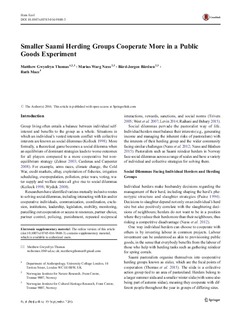Smaller saami herding groups cooperate more in a public goods experiment
Journal article, Peer reviewed
Permanent lenke
http://hdl.handle.net/11250/2411185Utgivelsesdato
2016Metadata
Vis full innførselSamlinger
- Publikasjoner fra CRIStin - NINA [2364]
- Scientific publications [1392]
Sammendrag
Group living often entails a balance between individual selfinterest
and benefits to the group as a whole. Situations in
which an individual’s vested interests conflict with collective interests are known as social dilemmas (Kollock 1998). More
formally, a theoretical game becomes a social dilemma when
an equilibriumof dominant strategies leads to worse outcomes
for all players compared to a more cooperative but nonequilibrium
strategy (Zelmer 2003; Cardenas and Carpenter
2008). For example, arms races, climate change, the Cold
War, credit markets, eBay, exploitation of fisheries, irrigation
scheduling, overpopulation, pollution, price wars, voting, water
supply and welfare states all give rise to social dilemmas
(Kollock 1998; Wydick 2008).
Researchers have identified various mutually inclusive routes
to solving social dilemmas, including interacting with kin and/or
cooperative individuals, communication, coordination, exclusion,
institutions, leadership, legislation, mobility, monitoring,
parcelling out cooperation or access to resources, partner choice,
partner control, policing, punishment, repeated reciprocalinteractions, rewards, sanctions, and social norms (Trivers
2005; West et al. 2007; Levin 2014; Raihani and Bshary 2015).
Social dilemmas pervade the pastoralist way of life.
Individual herders must balance their interests (e.g., generating
income and managing the inherent risks of pastoralism) with
the interests of their herding group and the wider community
facing similar challenges (Næss et al. 2012; Næss and Bårdsen
2015). Pastoralists such as Saami reindeer herders in Norway
face social dilemmas across a range of scales and have a variety
of individual and collective strategies for solving them.
interests are known as social dilemmas (Kollock 1998). More
formally, a theoretical game becomes a social dilemma when
an equilibriumof dominant strategies leads to worse outcomes
for all players compared to a more cooperative but nonequilibrium
strategy (Zelmer 2003; Cardenas and Carpenter
2008). For example, arms races, climate change, the Cold
War, credit markets, eBay, exploitation of fisheries, irrigation
scheduling, overpopulation, pollution, price wars, voting, water
supply and welfare states all give rise to social dilemmas
(Kollock 1998; Wydick 2008).
Researchers have identified various mutually inclusive routes
to solving social dilemmas, including interacting with kin and/or
cooperative individuals, communication, coordination, exclusion,
institutions, leadership, legislation, mobility, monitoring,
parcelling out cooperation or access to resources, partner choice,
partner control, policing, punishment, repeated reciprocal
interactions, rewards, sanctions, and social norms (Trivers
2005; West et al. 2007; Levin 2014; Raihani and Bshary 2015).
Social dilemmas pervade the pastoralist way of life.
Individual herders must balance their interests (e.g., generating
income and managing the inherent risks of pastoralism) with
the interests of their herding group and the wider community
facing similar challenges (Næss et al. 2012; Næss and Bårdsen
2015). Pastoralists such as Saami reindeer herders in Norway
face social dilemmas across a range of scales and have a variety
of individual and collective strategies for solving them.

